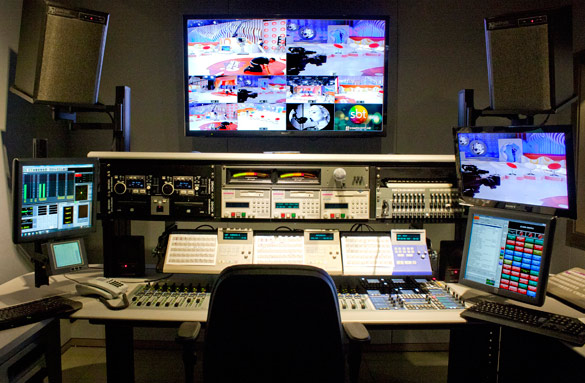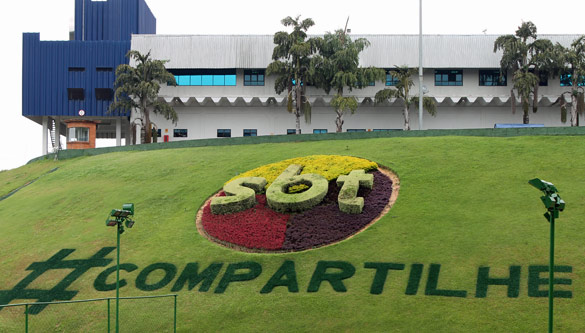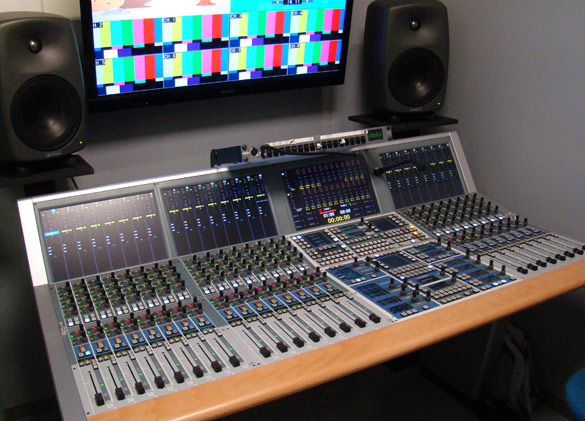Brazilian TV Station SBT Upgrades Its Intercom Systems
In this article we will focus on the replacement of the outdated intercom system by intelligent integration of oratis components but SBT not only replaced its intercoms. SBT also installed new CRESCENDO consoles and three special STAGETEC ON AIR 24 desks, which were designed to suit SBT's requirements.
The set-up includes a comprehensive NEXUS audio network which can exchange signals with the oratis system through MADI lines. This whole installation is a real landmark in the Brazilian market. For all supplied and installed systems and also for third-party products such as the wireless belt-pack system, SBT has one single point of contact. The MEDIAGROUP headquarters in Buttenheim were responsible for all parts of the project which took place in Germany. The entire project execution, the concept and all on-site work was undertaken by ASPA STAGETEC BRASIL.
Brazil is also the sixth largest economy in the world and boasts incredible growth. As host of the FIFA World Cup in 2014 and the Summer Olympics in 2016, the country will talked about a lot over the next few years and there will certainly be many an exciting broadcast installation. However, Brazil's broadcast landscape with almost 3,000 mostly commercial radio stations and about 270 TV stations is already well worth a look today.
One of these stations, SBT, is based in São Paulo. It is focused on popular entertainment content and news and is very successful. It was founded more than 30 years ago by the flamboyant entrepreneur Silvio Santos who is still leading the business. SBT's technical systems are getting on in years and are being replaced one by one during on-going operation. Such a scenario is always a complex task and this is especially true when one of the key production tools comes into focus: the intercom. This system connects almost all the production facilities together. A complete replacement would mean rewiring the entire premises. The only other option is to install a new system utilising the existing infrastructure.

Reusing the Existing Cabling
The old analogue intercom system had long since been amortised. The time had come to look for an up-to-date solution, primarily to improve the whole production environment by implementing a versatile and future-proof solution. Meanwhile, the old systems started to need intense servicing and SBT had already begun examining the intercom market two years ago. Augusto Reis Oliveira, Commercial Manager of ASPA STAGETEC BRASIL, remembers: "When we introduced the oratis system for the first time, the SBT managers were very impressed. Celso Lucio and Lauro Tenguan, responsible for the Intercom Project, were amazed by the quality of the system, its reliability and the manifold configuration possibilities."
The existing analogue subscriber units were connected to the analogue intercom matrix via fixed coaxial cabling. Since there were no plans to change the physical location of the subscriber units, the new oratis system was designed so that they could continue to use the existing coaxial cable. This time however, the new oratis subscriber units connect digitally to the central oratis matrix frames. So oratis' flexible cabling options came in very handy in this installation. Each of the 75-ohm coaxial cables equipped with BNC connectors can support two bidirectional audio channels in AES/EBU format. This change to the professional digital standard in stereo with 48 kHz sampling rate and 24 bit quantisation depth yields an enormous improvement in audio quality immediately. SBT is a big station with a lot of intercom units.
The overall system includes 133 subscriber units in total, almost half of which were supplemented with expansion modules, 57 in total. Each subscriber unit connects to one of the four matrix frames which are themselves connected to an R4000 router, forming a large overall intercom system. Cross-linking of the matrix frames and router is by dedicated 1-Gbps lines which were installed easily in the equipment room. This setup allowed for retaining the legacy base infrastructure which had demonstrated excellent performance in the past.
"This is our very first big oratis project based on coaxial cabling," explains Augusto Oliveira. "Reusing the existing cables was one of the crucial aspects when it came to awarding the contract for the project!" Other important criteria were ease of integration, reliability and the wide variety of features. After testing the system extensively for weeks, Celso Lucio and Lauro Tenguan were convinced that oratis is the most advanced system on the market.
Plain Text Labelling
The existing system already had the possibility of assigning an alphanumerical label to each subscriber. For this purpose, the legacy subscriber units were equipped with LCD keys. This was certainly a high-quality and costly solution for its time because such keys are relatively expensive. However, for current expectations the label length was too short, making the labels confusing in daily operation. SBT, though, would not forgo this type of user interface. It had proved to be very successful, in particular, for the non-technical personnel who are the typical subscriber-unit users.
This was exactly the idea which the oratis subscriber units improved on. The target-key labels can be up to 18 characters in length. This way, each subscriber can be contacted by his or her name and or function without the necessity of resorting to using abbreviations. Sophisticated use of colour to indicate the call status of each key is another advantage. These two features – 18-character labels and multi-coloured signalling – make the oratis subscriber units stand out in the market and, in particular, in their price range. Ricardo Cuenca, Engineering Manager of ASPA STAGETEC BRASIL, puts it like this: "For a high level of user acceptance, it is extremely important that they feel comfortable with the subscriber-unit user interface. 90% of intercom users have no technical background."
No Cable Required
The technical crew also experience the really sophisticated possibilities of the new intercom system. After the switch to the DELEC system, the system administrator can manage the entire system centrally for the first time. Now, he or she is able to configure each subscriber unit and assign target keys straightforwardly using drag & drop on a PC installed anywhere on the network. For the users, operation of these pre-configured subscriber units very quickly become self-explanatory. Fixed subscriber units only fulfil some of the intercom requirements in a production. Not every employee has a role which ties them to a specific location where a subscriber unit might be installed.
In TV production it is therefore commonplace to equip all roving employees with wireless belt packs. DELEC systems are very open at this point. Ultimately, any wireless system requested by the customer can be integrated seamlessly into an oratis system. Since the wireless system for belt packs in use at the time when the upgrade was specified was long outdated, the MEDIAGROUP also supplied a new system comprising 77 DECT-connected belt packs and 16 base units. SBT thus obtained their entire new intercom solution from a single source.
Overnight Switchover
In one week, during the first quarter of the year, the people of São Paulo hold their carnival celebrations with much devotion and magnificent processions. The new system was deliberately only commissioned after carnival; however, many preparations had been completed in the background long before. The entire new system was installed and tested thoroughly in a space that was not needed for current productions.
During these test runs, engineers defined the necessary configurations, and the system administrator had the opportunity to conduct in-depth studies of the new system. Afterwards, key users received a quick training on the new system. Thanks to the unchanged basic philosophy of the system however, end-user training could be very short. Following this test phase, the oratis matrix frames and the oratis R4000 router were installed and networked in the equipment room.
The only things left to do were to replace the subscriber units and connect them to the new matrix frames. Thanks to excellent preparation this was an easy step. Overnight, the old subscriber units were removed and the new DELEC units installed in the original locations and connected using the existing coaxial cabling. From a mechanical perspective, this was not a problem since the new subscriber units have a very shallow mounting depth. The overall 19" width and the height of one unit are standardised in any case, so that even the existing installation frames could be reused. The next morning, the system was fully functional and ready for everyday use.
 How to resolve AdBlock issue?
How to resolve AdBlock issue? 
